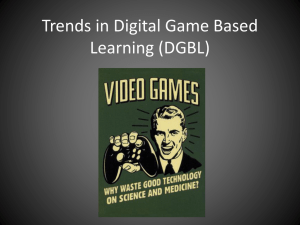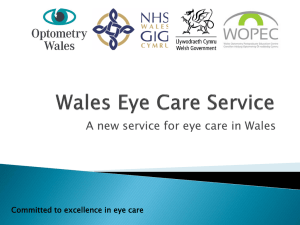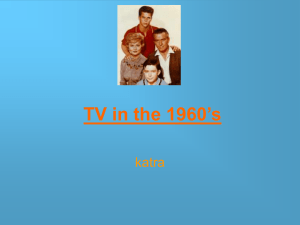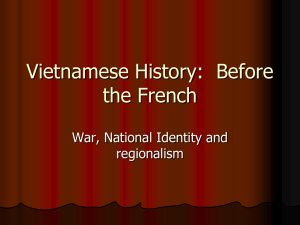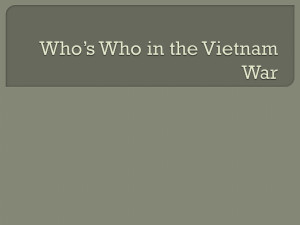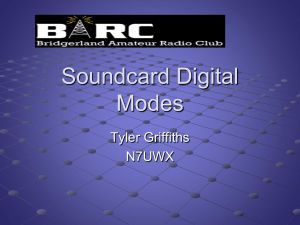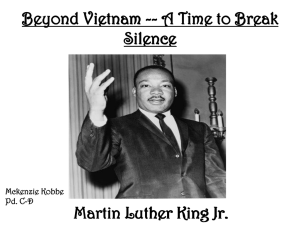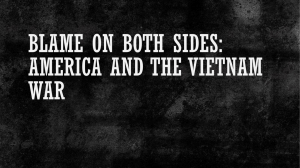George_Petry_
advertisement
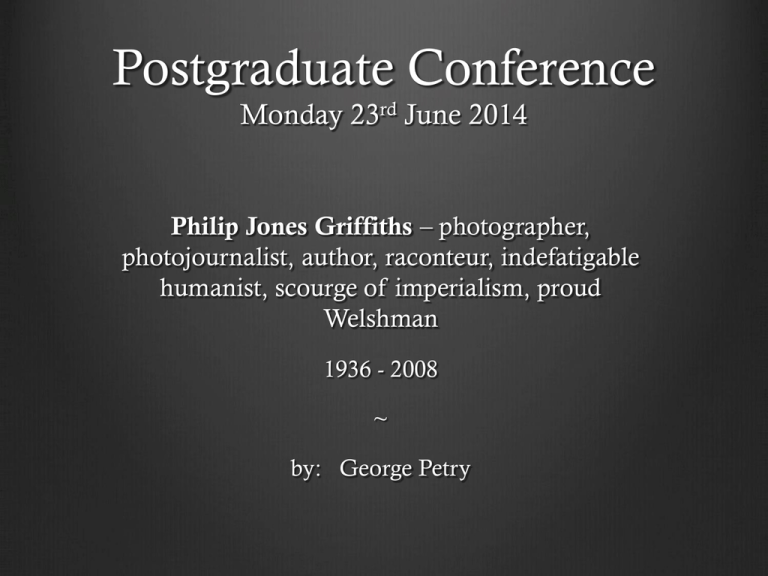
Postgraduate Conference Monday 23rd June 2014 Philip Jones Griffiths – photographer, photojournalist, author, raconteur, indefatigable humanist, scourge of imperialism, proud Welshman 1936 - 2008 ~ by: George Petry Philip Jones Griffiths in Vietnam, circa 1966 “One country and one war gave Philip the chance to say something very profound, very important to him, about life as he sees and understands it. Turn to his images, the last of their kind that we shall see, made in unrepeatable circumstances, by a rare talent – by my fearless friend Philip, a most original photographer with a very Welsh kind of genius.” Murray Sayle, (investigative journalist) from Dark Odyssey Scope of the Research Project Examination of the unique, untouched Griffiths archive out of which was born Vietnam Inc. – the 1971 book ( 266 images over 223 pages) An archive is… Traces of the past, collected either intentionally or hapazardly as ‘evidence’. Antoinette Burton, Archive Stories Archives are created, drawn upon and experienced by those who use them to write history. Antoinette Burton, Archive Stories “…shaped as much by national identity, gender, race and class, as by professional training...” Antoinette Burton, Archive Stories The start point, particularly for photographic documents, from which “…documents can speak for themselves and what the relationship is between ‘fact’ and ‘interpretation’. Ann Curthoys, The History of Killing One of six shelves of boxes of mainly photographic material. National Library of Wales The Griffiths archive, Magnum, New York office, 2013 Scope of the Research Project Examination of the unique, untouched Griffiths archive out of which was born Vietnam Inc. – the 1971 book ( 266 images over 223 pages) Evaluation of Griffiths’ photographs capturing war suffering One of Griffiths’s 266 images Innocence and Anguish Vietnam Inc. p151 Susan said… “A photograph has only one language and is destined for all.” Regarding the Pain of Others, 2003 “Photographs do not explain, they acknowledge.” On Photography, 1971 “Industrial societies turn their citizens into image-junkies; it is the most irresistible form of mental pollution.” On Photography, 1971 “Are you waiting for a shell to go off so you can photograph some corpses?” Regarding the Pain of Others, 2003 Questions on Suffering It is not beautiful…. Can photographing and publishing images of suffering be justified? By whom…..for whom? Spectacle or News? Intrusion on privacy, or informative plea for help Documenting and evidencing extremes in human conditions Aesthetics or atrocities of war porn? Fabrication, manipulation, set up? Scope of the Research Project Examination of the unique, untouched Griffiths archive out of which was born Vietnam Inc. – the 1971 book ( 266 images over 223 pages) Evaluation of Griffiths’ photographs capturing war suffering Evaluating the possibility of a notion of ‘Welshness’ having a tangible, subliminal, powerfully influencing presence on Griffiths the photographer? What is Welshness? JMW Turner (1775-1851) sets the scene: “…Turner’s sombre, brooding pictures of Wales were intended to evoke in the consciousness of British connoisseurs…..” “Like the imaginary spaces of the Gothic Novel which so influenced Turner, the dark spaces of his Welsh pictures symbolise the blockages and obstacles placed in the way of the exercise of power.” Rod Jones, Wales the Imagined Nation What is Welshness? Welshness is not a stereotype Welshness is not an ideology or ethnopsychology Welshness is not strict ethnicity or ‘a people’ Welshness is not politics or a religion Welshness is vital to grasp and impossible to define ~ “The Welsh as a people have lived by making and remaking themselves in generation after generation, usually against the odds, usually within a British context. In that making and remaking of themselves, a sense of history has been central.” Gwyn A. Williams, When was Wales? Key Welshness characteristics Kenneth O. Morgan in: Rebirth of a Nation: Plaid Cymru’s main concerns were moral, intellectual and cultural: Making of Welsh the only official language in government administration, business and in education instruction Nationalist ‘pacific’ nature and movement Asserting and defining Welsh identity in literary periodicals, Eisteddfod platforms, Dislike/distrust of imperialism, of influence from ‘foreign’ England Carol Trosset in: Welshness Performed: The importance of language, history and sense of community Christian/Methodist-based values of integrity, hard work, modesty National Eisteddfod held accountable for maintaining many cultural traditions Presence of dominant England as a scapegoat of unwanted contaminating cultural influences Scope of the Research Project Examination of the unique, untouched Griffiths archive out of which was born Vietnam Inc. – the 1971 book ( 266 images over 223 pages) Evaluation of Griffiths’ photographs capturing war suffering Evaluating the possibility of a notion of ‘Welshness’ having a tangible, subliminal, powerfully influencing presence on Griffiths the photographer? Hopefully to bring greater knowledge, understanding and exposure of Philip Jones Griffiths to Wales and Welsh cultural history, as a contemporary paragon of photojournalism The Research Question “Philip Jones Griffiths gave his life meaning through the medium of photography. In Vietnam, did he connect English governments historically projecting an imperialist power over the Welsh, with the treatment and suffering of the Vietnamese people in a brutal war which he saw as a projection of US imperialist power? The Hypothesis “If it is reasonable to believe that any photographer born in any culture will apply his or her cultural identity, with its’ attendant histories, belief systems, values, traditions, experiences, prejudices and myths, consciously or subconsciously, to their photography, then why not this Welshman? The hypothesis posits that Griffiths, raised in North Wales in the 1930s to 1950s would carry that particular area’s cultural notion of Welshness, as a memory influencing his views on life and the composition and choices of subject in his photographic work, through war and the suffering of an alien country - namely Vietnam?” So what does this mean? What is culture? Raymond Williams, 1988, in Keywords describes it as: One of the two or three most complicated words in the English language (Welsh – diwylliant) A complex argument about relations between general human development and a particular way of life, and between both the works and practices of art and intelligence. In cultural anthropology the reference to culture or a culture is primarily to material production; while in cultural studies the reference is primarily to signifying or symbolic systems. So what? Cultural interpretation resides in people in a war – natives and visitors; and incomers bring their own. Photographers, journalists also bring their own The national identity/cultural background of the photographer is an inevitable influence on: Photographic style/preferences: place, time, subject of shoot Welshness was Griffiths’s cultural influencing background in Vietnam Vietnam Inc. was the result Methodology Examine the Vietnam period archive 1966-1971 alongside Vietnam Inc. Extract data from key sources: The Archive - contact sheets and other documents Vietnam Inc. – photographs, narratives and captions Interviews with family, colleagues, friends, others Key data analysis tools: Used on population of 26 representative photographs (10%) from Vietnam Inc. Templates critical analysis tools (Szarkowski & Tinkler) Analytical Tools John Szarkowski Penny Tinkler The Five Characteristics of a Photograph The Five Lines of Enquiry From: Using Photographs in Social and Historical Research From: The Photographer’s Eye •The Thing itself • Identification of basic details •The Detail • Scrutiny of the image •The Frame • Photographs as material objects •Time • Contextual situation •Vantage Point • Meanings of a photograph The Photographer “When creating a pictorial event, the photographer selects a particular frame of reference for the viewer: the lighting, the camera angle, the perspective, the lines and forms, the framing, the balance, and the overall compositional arrangement. In short, the recorder of the pictorial event controls the manner in which the information is presented.” ROBERT N. KRAFT, 1987 Grinnell College, Grinnell, Iowa Now it is your turn…… “If I like a photograph, if it disturbs me, I linger over it. What am I doing, during the time I remain with it? I look at it, I scrutinize it, as if I wanted to know more about the thing or the person it represents.” Roland Barthes, Camera Lucida, 1993 Photographs by six strongly individual international photojournalists working in Vietnam Consider the image; do you think there may be a cultural sense of national identity at work in the photographer’s style, or subject or composition? Consider these against similar compositions by Griffiths ‘Burning Monk’ Thich Quang Duc, Saigon 1963 Malcolm Browne (American), 1964 Pulitzer prize winner Associated Press “Burning Home” With compliments of the ‘Zippo Squad’ Philip Jones Griffiths (Welsh), 1967 ‘Zippo Squad’ soldier at work Philip Jones Griffiths (Welsh), 1967 ‘Saigon Execution’ Gen Loan executes a VC officer Eddie Adams (American), 1969 Pulitzer prize winner Associated Press VC guerrilla body in street Eddie Adams (American), 5 May 1968 Innocent civilian in street - USAF bombing, Hué Philip Jones Griffiths (Welsh), 1968, [orig colour] VC body dragged away for burial - Battle of Long Tan Kyoichi Sawada (Japanese) - 1966 Pulitzer prize winner UPI Mother with children crossing river to safety during USAF bombing run on their village in Loc Thuong Kyoichi Sawada (Japanese) UPI Mother and children being ‘relocated’ from their village, for their safety, by a GI patrol Philip Jones Griffiths (Welsh), 1968 ‘The Terror of War’ Kim Phuc – ‘The Napalm Girl’ Huỳnh Công Út (Nick) Ut (Vietnamese), 1973 Pulitzer prize winner Associated Press ‘The Terror of War’ Napalm man – name unknown Philip Jones Griffiths (Welsh), 1967 Wounded GI – ‘crucifixion’ Don McCullin (English), 1968, Battle of Hué, Sunday Times Crucifixion, rural interpretation Philip Jones Griffiths (Welsh), 1970 Bandage; wounded GIs Henri Huet (French), 1966, Robert Capa Gold Medal Winner from Overseas Press Club Associated Press Bandage; napalm wounded civilian Philip Jones Griffiths (Welsh), 1967 ~ No award necessary ~ From a note Philip wrote, found in an archived box: “For years afterwards Vietnam continued to make it’s nocturnal visits to my mind. Never nightmares, mostly pleasant. This always surprised me as Vietnam was anything but pleasant from 1966 to 1971. It was a fairground with real people for sitting ducks. Fairgrounds are dangerous places, people are robbed, pockets are picked, girls are raped, whole families are wiped out when the roller coaster fails to make a bend and carrousels speed up out of control throwing young children to oblivion. On returning home penniless any gifts won are found to be useless/worthless. But it was exciting! People do crazy things in fairgrounds - like waterskiing in a battle zone. (If you think that scene in ‘Apocalypse Now’ was a product of Coppola’s imagination I photographed the real thing in 1967 - there was even a ‘Kurtz’ present, except that he would make the villagers kiss his boots and while their tongues licked the dust off his boots he blew their brains out.” Thank you
